Mobile games have evolved to rival traditional gaming consoles and PCs, yet face the same challenges as any other app in the market. This means marketers and game developers must continually engage with users to prevent the risk of uninstalls.
Sending game notifications is an effective strategy to keep users engaged, significantly improving app engagement and reducing customer churn.
While sending game notifications is key to keeping them engaged, sending too many can become annoying. It’s crucial to find a balance, but achieving this is often easier said than done.
However, some of the world’s top gaming apps have mastered this balance. In this blog, we will highlight the top 5 gaming apps known for their push notifications strategies. We will also share some of the proven practices to employ while sending push notifications to keep users engaged without tipping into annoyance.
What is the Cost Dynamics in the Mobile Gaming Industry?
Mobile gaming has surged in popularity to become a leading platform in the gaming world. According to Statista, there were 300 billion apps downloaded in 2023, and more than 50% were games. This underscores the massive appeal and growth of mobile games.
However, this rise in gaming apps brings a high cost of acquiring customers, presenting a significant challenge for marketers.
The user acquisition cost (CAC) or cost per install (CPI) for gaming apps is very steep. Research shows that the average CPI for gaming apps ranges between $2 – $5 for iOS and $1.5 – $4 for Android, which is only increasing every year. Understanding these costs is crucial for budgeting and curating user retention strategies.
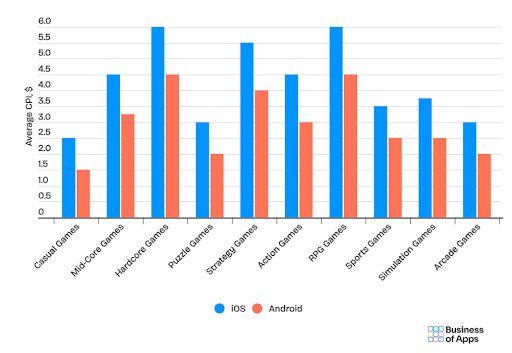
Average CPI Across Different Kinds of Game on iOS and Android
While user acquisition is only half the battle, retaining these users is equally daunting. Research indicates that the retention rate of these gaming apps is reducing to a meager 2% – 3% within 30 days after installation.
Sending regular push notifications is a strategic way to tame user drop-offs, keep users engaged, and prevent customer churn. Sending game notifications that are personalized, relevant, and timely will drive clicks & conversions by 2x, improving engagement and retention rate.
Leveraging a customer engagement platform that offers push notifications is a cost-effective alternative compared to more expensive retargeting ads. Such platforms reduce costs and provide deeper insights into how users are engaging with your app over time through benefits such as cohort retention analysis. These features provide actionable insights beyond app downloads that will aid in campaigns to improve user retention.
Every mobile app needs some amount of nudging to get its users to launch it. Gaming apps, particularly, are vulnerable to getting lost in the swarm of other apps. In the list below, we highlight some of the best game notifications that leverage push notifications to their advantage. These push notifications are both captivating and click-worthy, designed to stand out and improve engagement.
5 Top Game Notification Examples
Here are 5 leading mobile gaming apps that are acing their push notification user engagement game:
1. Wordscapes
Who doesn’t love puzzles? No, we aren’t talking about Sudoku or Crosswords, but this addictive mobile gaming app called Wordscapes! It doesn’t just make a positive impact through great user onboarding and a pleasant UI/UX but also nails its push notifications, that have the right engagement essence.
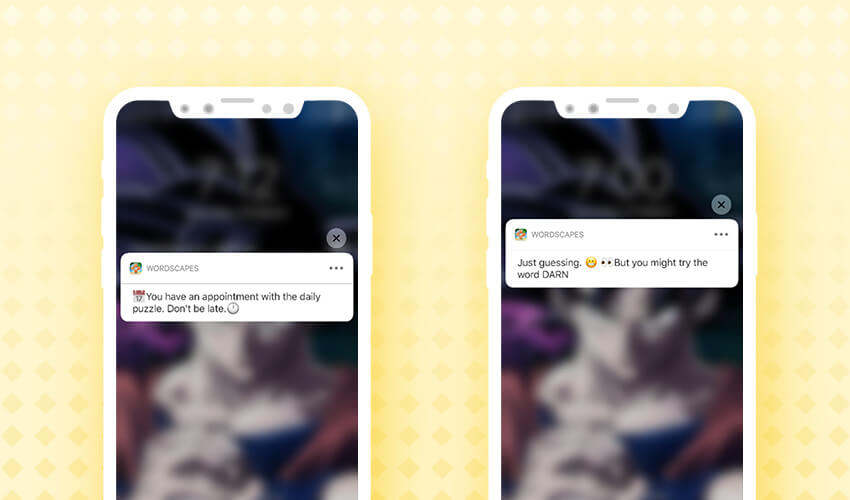
These push notifications are effective for the following reasons:
- Timeliness & Relevance – The first game notification reminds the user about the “appointment with the daily puzzle.” This leverages the idea of daily engagement and taps into the sense of routine and urgency.
- Actionable content – Both notifications include content that directly relates to action – either to participate in the daily activity or solve part of a game. This direct CTA can drive app opens and engagement with the app.
- Notification Emojis: WordScapes balance its push notifications through the effective use of relevant notification emojis without going overboard. This makes an instant visual impact while encouraging users read the entire notification message, at least once.
- Sending Hints – Usually, one must have observed a pattern – if users can’t clear a particular level, they move on from the game, resulting in falling app relaunches and, eventually, user churn. This game notification has a unique way of bringing users back to the app by sending occasional hints. Not only does this personalize the user experience based on which level the user is on, but it also gives such users a concrete reason to relaunch the app, driving higher app usage.
2. Candy Crush
Remember the good old Tetris game? Candy Crush is also a free-to-play match-three puzzle mobile game. The game is such a big hit that it was the most downloaded app across app stores, becoming the first mobile game to file and release its IPO! The true definition of a viral app is based on a great UI/UX and a solid mobile marketing strategy. Candy Crush also sends push notifications to nudge its users to relaunch the app.
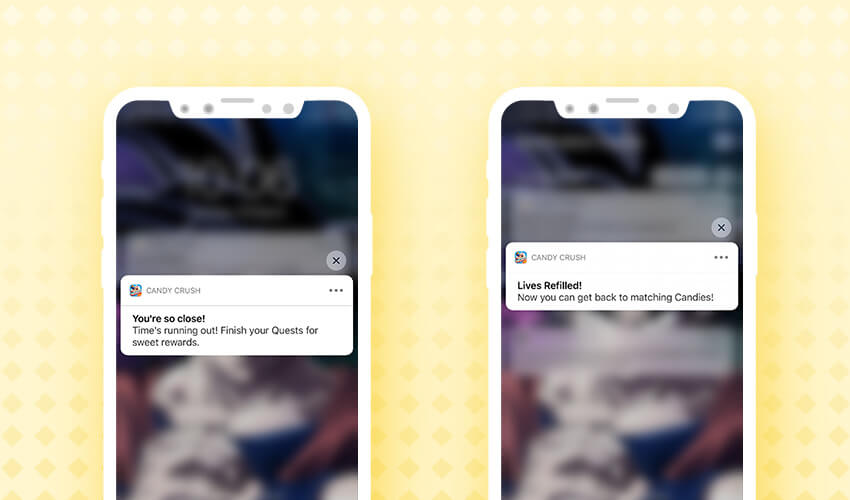
These push notifications are effective for the following reasons:
- Contextual Notification Message: There are players who play the game every day and are very particular about the level they are playing and their progress. The notification messaging has to be straight to the point. This game notification subtly nudges the user to launch the game and finish the level to get higher rewards.
- Sense of Urgency: This app notification creates a sense of urgency and that the lives are refilled, nudging the users to keep leveling up.
3. Pokemon GO
Pokémon GO is an augmented reality (AR) mobile game developed and published by Niantic for iOS and Android devices. It is a location-based AR game where the user has to move around with the smartphone to “catch” the Pokemons! The marketers at Pokemon GO also effectively leverage the power push notifications. This game notification from Pokemon GO acts as a perfect example for re-engaging a dormant user.
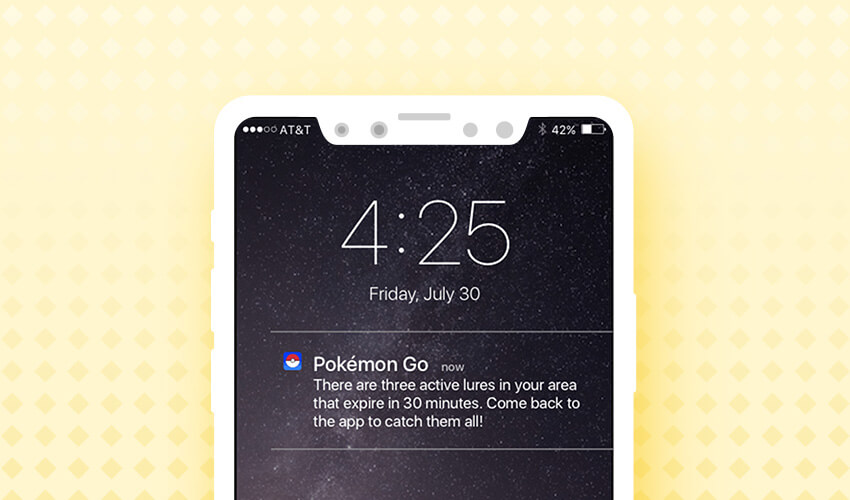
This push notification works for the following reasons:
- Targeting: Pokemon GO lets the players be aware of the active lures in their area by sending this timely geolocation-based push notification.
- Sense of urgency: This game notification puts a sense of urgency in the notification message to nudge the user to launch the app and play it right away!
Mobile marketers at gaming apps have a lot more liberty to be creative with their notification message. This is why mobile A/B testing becomes important to identify what notification message and creatives work best with what audiences.
4. Shadow Fight 3
Shadow Fight 3 is a brawler gaming app developed by Nekki. Nekki’s games are quite famous in this genre, and they have had huge success in Shadow Fight 1 and Shadow Fight 2.
Shadow Fight 2 was when the developers first decided to use push notifications to nudge their users to play the game. But this year, with Shadow Fight 3, they’ve taken their push notification game up a notch.
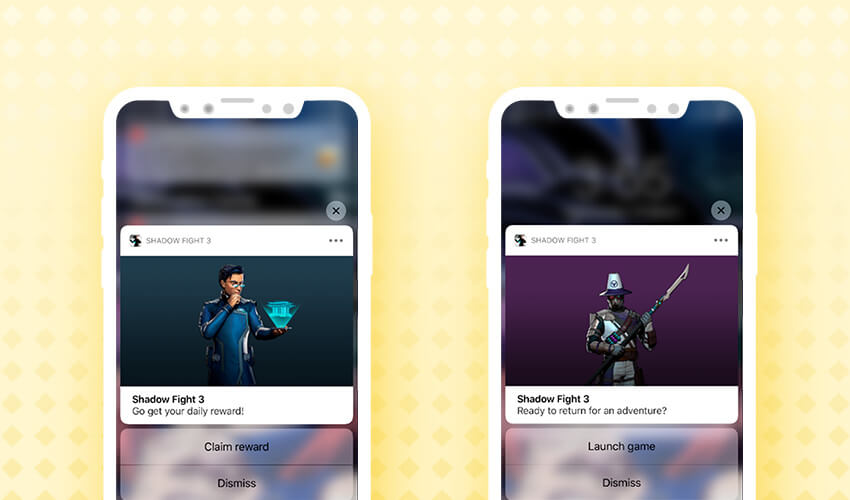
This push notification works for the following reasons:
- Rich Elements: When was the last time you saw a gaming app that used a rich push notification? Clearly, the makers of this game have realized that one major way to rise above the competition is through the use of images in their push notification campaigns. Not only does this make the notification message visually appealing, but it also increases the chances of users relaunching the app to get back to their gaming journey.
- Relevant CTAs: Take a look at these two push notifications. Both have two different CTAs with relevant actions tied back to what the notification message actually means. This ensures that users do not view the push notification as overly intrusive, giving them the option to either follow through on a positive action or dismiss it altogether. The last thing marketers should do is annoy their users!
5. Dream11
Dream11 is India’s first and largest single-match fantasy sports game. Players use their knowledge of sports to create a virtual fantasy team of real-life players. They then earn points based on how those players perform in actual matches.
With over 50 million users, Dream11 has registered a phenomenal 100X growth in less than 5 years. One major reason for its exceptional user engagement and retention has been the manner in which they’ve used highly personalized and timely push notifications.
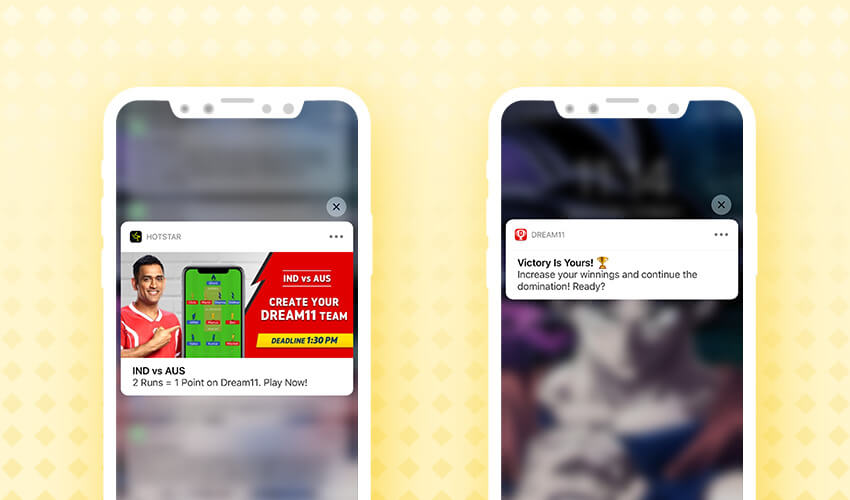
- User of Rich Media: This is another great example of using rich media in push notifications. The banner clearly communicates more value through the use of engaging creative assets with specific deadlines. By creating a sense of urgency or a fear of missing out (FOMO), Dream11 nudges interested users to come back to the app and create their teams at the earliest.
- Cross-App Messaging: In the above game notification, you can see Hotstar, in partnership with Dream11, sends a push notification covering both user bases.
- Personalized and contextual notification message: After every win, Dream11 sends a push notification to congratulate those users who may have won the contest.
It also sends notification messages reminding of your last victory, right before the next match. By encouraging “winners” to extend their winning streak, Dream11 strikes an emotional chord with such users, nudging them to relaunch the app.
Best Practices to Follow for Sending Mobile Game Notifications
1. Get Users to Opt-in
With stringent privacy laws in force, marketers need to obtain permission from users to opt-in. This includes both iOS and android push notifications. Users must willingly opt-in to receive notifications, ensuring compliance with privacy regulations.
As a marketer, you only get one chance to get users to op-in post downloads. This makes timing crucial. Ideally, it is best to launch the prompt during the onboarding process, balancing promptness with user engagement.
It is also recommended to provide context when asking users to opt-in. A generic message for push notification message is bound to get rejected. With that you can loose your only opportunity to engage with them meaningfully.
Instead, tell them what’s in it for them. Like the example given below.
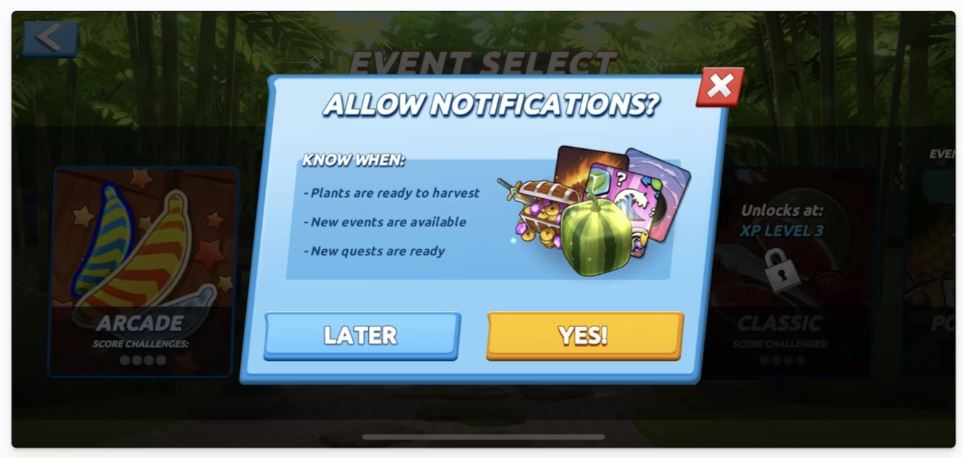
Tell players why they should opt-in
2. Make it Relevant and Specific
53% of users say they delete their app because of too many irrelevant push notifications.
This means users seek highly personalized messages that value their overall experience and stand out from the dozens of other notifications.
For example, instead of sending a message like “Hey John, where you been? We haven’t seen you play. Come back?”: use a more personalized message that will create a sense of urgency such as “”John, your championship title is at risk! 🏆 Defend your top spot in the leaderboard by joining the live tournament starting in 30 mins. Click to defend your honor!”
3. Ensure Your Game Notifications are Personalized
While basic personalization of push notifications can increase the open rates by 9%, many gaming apps overlook this straightforward tactic. To truly capitalize on the potential push notifications, it’s essential to go beyond basic customization and tailor it based on the user’s history, engagement, and behavior with the app.
When all these elements are combined, they result in a truly unique user experience.
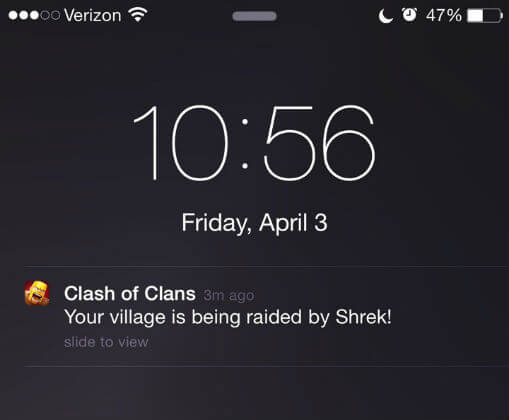
Personalized push notification
4. Always A/B Test your Push Notifications
All the practices shared will steer you in the right direction, but the best way to determine what truly works for your specific game is through A/B testing your notifications.
This method is not only essential for fine-tuning your approach but also invaluable for understanding the preferences of different player segments, allowing you to customize your engagement tactics effectively.
The advantage of split testing your push notifications is the ability to experiment with every element, such as ad copy, call-to-action, message tone, timing, and frequency. This method eliminates guesswork and helps develop notifications that are empirically proven to be effective, ensuring you’re implementing strategies that genuinely resonate with your audience.
However, don’t expect to do this once and think you have figured it out. A/B testing is an ongoing process of collecting data and optimizing your game notifications accordingly.
5. Localize your Push Notifications
Localizing your push notifications to match the user’s language and region is essential. By customizing messages to be culturally appropriate, you ensure that they resonate more effectively with your audience. Communicating in the users’ native language and considering their cultural context enhances connections and improves your chances of users clicking.
Conclusion
It would be wrong to assume that gaming apps don’t need push notifications because users will launch them daily.
Be it a gaming app or not, every mobile app needs push notifications in one of the lifecycle stages – right from acquisition and onboarding to engagement and retention, where they prevent their users from falling through the cracks.
Remember, push notifications can help retain 3x—10x more users in your game. They can improve engagement with personalized content or re-engage with players who haven’t visited your game for a while by delivering targeted, geolocation-based, context-specific, and meaningful notification messages in real-time.












